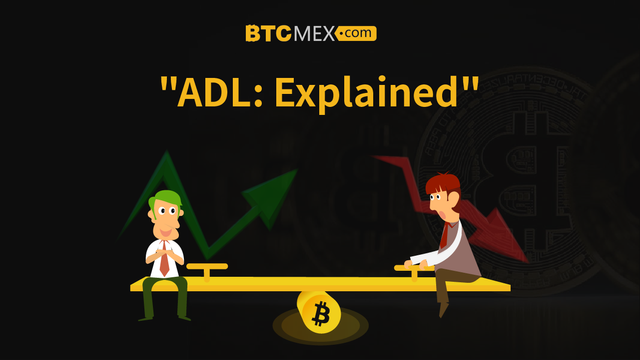BTCMEX: Clues to Auto-Deleveraging
One of the distinct features of cryptocurrency derivatives trading on the exchange is the extreme price volatility. With the high Leverage, it can be much more profitable than trading on the Spot Market, but it increases the risk of losses at the same time. Today crypto Futures exchanges are using two main types of a contract loss covering system: Socialized Loss and ADL — Auto-Deleveraging. BTCMEX — Bitcoin Perpetual Contracts innovative trading platform — uses the ADL because it is a fairer and more user friendly service. The mechanism and advantages of the Auto-Deleveraging while trading cryptocurrencies are explained below.

During the event of a Liquidation there’s always a risk of loss posed by traders who have negative account balances when they are liquidated. In other words, when they are liquidated at a price worse than their Bankruptcy Price — a price, at which a trader loses his entire Margin. Liquidation is an automatic closing of the position due to a significant Margin loss.
To make trading safe and transparent BTCMEX uses the Dual-Price Mechanism, which means the Liquidation is triggered by the Mark Price (average BTC market price), while the liquidated position will be closed at the Last Traded Price (BTC price on the exchange). The Liquidation Execution Price is the Last Traded Price at the moment the position is closed. If the Execution Price at which a position is liquidated is better than the Bankruptcy Price, the funds will be added to the Insurance Fund. If the price is worse, the Insurance Funds will be used to cover the loss. If the Insurance Fund is insufficient to cover the loss on BTCMEX, the Auto-Deleveraging, or ADL, system will be triggered.
The Insurance Fund is a buffer that protects traders on a cryptocurrency exchange from a possible ADL by covering the contract loss first.
The Auto-Deleveraging system is only used when the Insurance Fund is insufficient to cover the possible contact loss after the Liquidation. ADL is a crypto exchange feature that automatically deleverages opposing traders’ positions by profit and Leverage priority. Unlike in a Socialized Loss system, which spreads the loss amount among all profitable traders on the exchange.
BTCMEX is convinced that, all the profitable traders shouldn’t suffer from other users’ loss. A single risky (high leveraged position) trader can create a large loss for all profitable traders, including low risk (low leveraged) ones. The ADL mechanism eliminates the unnecessary loss by automatically selecting high profitable and high leveraged traders to cover the existing loss first, establishing a fair Bitcoin trading environment.
Let’s take a look, how the ADL works on a crypto exchange. Every trader has an ADL ranking according to their profit and Leverage, calculated by the system. The traders with the highest ranking will be selecting for deleveraging first. When an ADL is triggered, the system matches one or several profiting positions with the liquidated order at the Bankruptcy Price. Long positions are only matched with Short positions, and the other way around. After the process is completed, the auto-deleveraged trader will receive a notification from BTCMEX and is free to re-enter the market. He may not be at the top of the ADL ranking anymore.
Here’s an example. Trader A holds a long position with 200 contracts and is liquidated with a loss. If trader B, with 230 contracts short position, has the highest ADL rank, the system will close 200 of those at A’s Bankruptcy Price. If trader B doesn’t have enough contracts, the system will automatically select trader C — the next one in the ADL ranking, and so on, until the loss is fully covered.
On BTCMEX, the Margin of the ADL traders remains untouched. Because the quantity of the contracts is reduced, the Leverage is automatically decreased, that’s why the procedure is called Auto-Deleveraging.
To summarize, in a rare case, when a trader is liquidated under the Bankruptcy Price and the Insurance Fund on BTCMEX is not sufficient to cover the loss, the Auto-Deleveraging system will be triggered. The ADL is a fairer solution in comparison to the Socialized Loss system, because it protects all the users from possible unnecessary losses, caused by the risky traders.

www.btcmex.com
Auto-Deleveraging (ADL): A loss covering system, that automatically deleverages opposing traders’ positions by profit and leverage priority. It is triggered when Insurance Fund is insufficient to cover the loss.
Socialized Loss: A loss covering system, which spreads the loss amount among all profitable traders on the exchange.
Liquidation: An automatic closing of the position due to a significant Margin loss.
Dual-Price Mechanism: A condition when Liquidation is triggered by an average market price and not the Last Traded Price of the exchange.
Insurance Fund: A balance on the exchange, filled by the Remaining Margin of a position liquidated at a price better than the Bankruptcy Price, and used to cover the loss from a position closed at a price worse than the Bankruptcy Price.